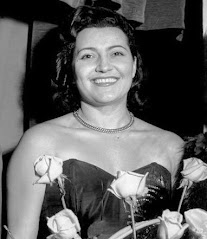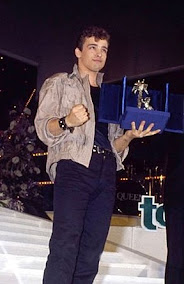NEW - Sanremo Music Festival - song contest
Historic annual event that inspired Eurovision
The first annual Sanremo Music Festival reached its conclusion on this day in 1951 with the song Grazie dei fiori - Thank You for the Flowers - announced as the winner, performed by the singer and actress Nilla Pizzi. The festival, which has taken place every year since its launch, is the world’s longest-running televised music contest, having been broadcast live by Italian state broadcaster Rai since 1955. Compared with the 2024 edition - the 74th - which is due to be staged from February 6 to February 10 - the inaugural competition was very different. There were 20 songs to be judged by the committee of experts who determined the result, but only three participants - Pizzi, Achille Togliani and the Duo Fasano, which consisted of twin sisters Dina and Delfina Fasano. All of the participants had to perform all of the songs over the course of the three nights with the judges having to decide on both the merits of the song and the quality of the three different renditions before settling on their winner. They were so impressed with Pizzi that the following year she not only was their choice to win the competition but took second and third places too. Read more…
_______________________________________
Mariuccia Mandelli - fashion designer
'Godmother of Italian fashion' was immortalised by Warhol
Mariuccia Mandelli, the founder of the fashion house Krizia, was born on this day in 1925 in Bergamo in northern Italy. Although Mandelli trained to be a primary school teacher on the advice of her mother and pursued a teaching career when she was in her 20s, she had a talent for sewing and had always been interested in fashion. It took just one lucky break to get her started. When a friend offered her the use of a flat rent-free for six months, Mandelli went to live there, bought an old sewing machine and started making clothes. She then launched her label, Krizia - a name by which she was sometimes known - by selling the clothes from her small car, a Fiat 500. She used to drive to shops in Milan with suitcases full of samples and by 1954 had established a ready-to-wear fashion house. Mandelli also went on to establish a popular line of men’s wear, one of the first female fashion designers to do this successfully. In 1964, Mandelli unveiled her first black-and-white collection at the Palazzo Pitti in Florence, the designs for which earned her a Critica della Moda award. Krizia grew rapidly during the 1960s and 1970s. Read more…
______________________________________
Bernardo Provenzano - Mafia boss
Head of Corleonesi clan dodged police for 43 years
Bernardo Provenzano, a Mafia boss who managed to evade the Sicilian police for 43 years after a warrant was issued for his arrest in 1963, was born on this day in 1933 in Corleone, the fabled town in the rugged countryside above Palermo that became famous for its association with Mario Puzo's novel The Godfather. The former farm labourer, who rose through the ranks to become the overall head - il capo di tutti i capi - of the so-called Cosa Nostra, lived for years under the eyes of the authorities in an opulent 18th century villa in a prestigious Palermo suburb, although ultimately he took refuge in the hills, alternating between two remote peasant farmhouses. He was finally captured and imprisoned in 2006 and died in the prisoners' ward of a Milan hospital 10 years later, aged 83. Although Provenzano assumed power during one of the bloodiest periods in Mafia history, he was eventually credited with rescuing the organisation from the brink of collapse by turning away from the violent path followed by his predecessor as capo di tutti i capi, Salvatore 'Toto' Riina, and restoring traditional Mafia values. Read more…
_____________________________________
Ernesto Basile - architect
Pioneer of Stile Liberty - the Italian twist on Art Nouveau
The architect Ernesto Basile, who would become known for his imaginative fusion of ancient, mediaeval and modern architectural elements and as a pioneer of Art Nouveau in Italy, was born on this day in 1857 in Palermo. His most impressive work was done in Rome, where he won a commission to rebuild almost completely the Palazzo Montecitorio, the home of the Chamber of Deputies of the Italian parliament. Yet his most wide-ranging impact was in Sicily, where he followed in the footsteps of his father, Giovan Battista Filippo Basile, in experimenting with the Art Nouveau style. Basile senior designed the Villa Favaloro, in Piazza Virgilio off Via Dante, and with Ernesto and others, notably Vincenzo Alagna, taking up the mantle, it was not long before entire districts of the city were dominated by Stile Liberty, the Italianate version of the Art Nouveau that took its name from the Liberty and Co store in London's Regent Street, which sold ornaments, fabric and objets d'art to a refined clientele and encouraged modern designers. Fine examples of Ernesto Basile’s architecture in Palermo include the Villino Florio (1899-1902) in Viale Regina Margherita, and the Hotel Villa Igiea (1899-1901) on the waterfront. Read more…
_____________________________________
Daniela Bianchi - actress
James Bond’s love interest whose Italian accent was never heard
Daniela Bianchi, an actress best known for her role as a Bond girl in the film From Russia With Love, was born on this day in 1942 in Rome. She played Russian agent Tatiana Romanova in the hit 1963 film starring Sean Connery as James Bond, although her voice had to be dubbed because of her Italian accent. Daniela’s parents originally came from Sirolo in Le Marche. Her father was a retired Italian army colonel and one of her grandmothers was a marchesa. Daniela was raised in Rome, where she studied ballet for eight years, and she then went on to become a fashion model. She was the winner of Miss Rome in 1960 and then runner-up in the Miss Universe contest the same year, where she was also voted Miss Photogenic by the press. Daniela was chosen over 200 other actresses by the Bond producers for the role of Tatiana Romanova and, at the age of 21, was the youngest ever main Bond girl. She was also the only Italian to be a main Bond girl. Her character, Tatiana, was a Russian cipher clerk who had been sent by Soviet Army Intelligence to entrap James Bond. Before and after making From Russia With Love, Daniela appeared in many French and Italian films. Read more…
_____________________________________
Charles Edward Stuart – royal exile
Bonnie Prince Charlie’s heart will forever be in Frascati
The Young Pretender to the British throne, sometimes known as Bonnie Prince Charlie, died on this day in 1788 in Rome. The man who would have been King Charles III was born and brought up in Italy where his father, James, the son of the exiled Stuart King James II, had been given a residence by Pope Clement XI. Charles Edward Stuart was raised as a Catholic and taught to believe he was a legitimate heir to the British throne. In 1745 Charles sailed to Scotland hoping to gather an army to help him place his father back on the thrones of England and Scotland. He defeated a Government army at the Battle of Prestonpans and marched south. He had got as far as Derbyshire when the decision was made by his troops to return to Scotland because of the lack of English support for their cause. They were pursued by King George II’s son, the Duke of Cumberland, who led troops against them at the Battle of Culloden in 1746. Many of his soldiers were shot and killed and the surviving Jacobites fled. They were pursued by Cumberland ’s men, who committed atrocities against them when they were caught. Read more…
_______________________________________
Don Bosco – Saint
Father and teacher who could do magic tricks
Saint John Bosco, who was often known as Don Bosco, died on this day in 1888 in Turin. He had dedicated his life to helping street children, juvenile delinquents and other disadvantaged young people and was made a saint by Pope Pius XI in 1934. Bosco is now the patron saint of apprentices, editors, publishers, children, young delinquents and magicians. He was born Giovanni Bosco in Becchi, just outside Castelnuovo d’Asti in Piedmont in 1815. His birth came just after the end of the Napoleonic Wars that had ravaged the area. Bosco’s father died when he was two, leaving him to be brought up by his mother, Margherita. Mama Margherita Occhiena would herself be declared venerable by the Catholic Church in 2006. Bosco attended Church and grew up to become very devout. Although his family was poor, his mother would share what they had with homeless people who came to the door. While Bosco was still young, he had the first of a series of dreams that would influence his life. He saw a group of poor boys who blasphemed while they played together, and a man told him that if he showed meekness and charity he would win over these boys. Read more…
_______________________________________
Book of the Day: Liguria (Bradt Travel Guides), by Rosie Whitehouse
Bradt's award-winning guide to Liguria is the essential companion to getting the most out of a visit to this beguiling Italian region. Author Rosie Whitehouse has spent 30 years exploring Liguria and in her comprehensive guide introduces you to not just the glitz of the Riviera but also to the delights of the wild unknown hinterlands and mountain valleys, including in-depth coverage of local gastronomic delights - a key part of any Ligurian visit. This edition includes new maps, a focus on of the growth of small, 'Slow Food' businesses, restaurants and hotels, in-depth coverage of Genoa as a cultural and weekend-break destination and the development of its striking Hennibique waterfront, the latest developments in Savona and La Spezia, more walks and bike-riding advice plus new suggested routes, revised hotel and restaurant listings and all the latest transport information. Liguria is a mountainous region of dizzy passes and breathtaking views, where the mountains plunge down into the sparkling blue waters of the Mediterranean. The narrow strip of coast includes the gems of the world famous Italian Riviera, the great port city of Genoa, the glitzy resort of Portofino and the charms of the Cinque Terre. Yet in the hinterland there are many beautiful villages and mountain walks that have yet to be discovered by tourists. Whether you're in search of pesto, trofie and freshly baked focaccia, a history buff on the hunt for Roman remains, culture addict dazzled by Genoa's glittering palazzi and top-class museums, or a family heading for a well-earned break, Bradt's Liguria is the ideal guide for travellers of all ages and all budgets.Rosie Whitehouse developed a love of travel when her parents bundled the family in the car and drove to Liguria in the summer of 1966. When her eldest son was just a month old she made her second trip to Liguria and fell in love with it. She now knows the place like the back of her hand, spending part of the year in the house there that her husband's family have owned for over 45 years. An Italian speaker, over the last 30 years and more Rosie has explored every corner of Liguria with her family and can offer a real insider's view.

.jpg)














.jpg)



.jpg)
.jpg)

